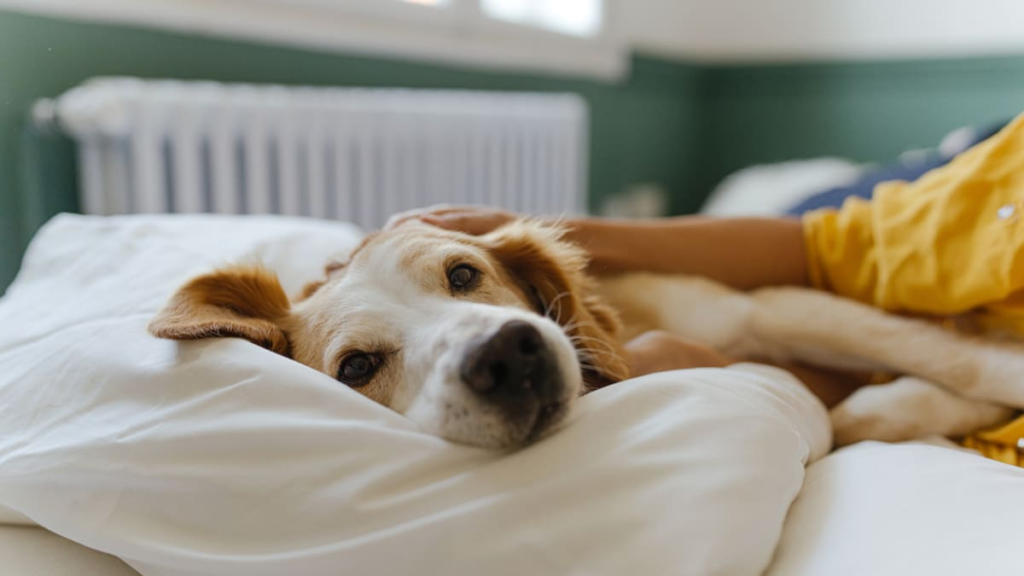
Dogs sleeping in the bed with their owners is a common habit, but it can have both benefits and challenges. Some people enjoy the companionship and warmth, while others find it disruptive to their sleep or want to establish boundaries for their dog. Whether you want to embrace or break the habit, it’s essential to understand why dogs do this and how to manage it effectively.
Why Do Dogs Like Sleeping in the Bed?
There are several reasons why dogs may prefer to sleep in your bed:
- Comfort and Warmth: Your bed is usually more comfortable than their own bedding, and dogs enjoy the warmth from being close to their owner.
- Pack Instinct: Dogs are naturally pack animals, and in the wild, they would sleep close to their pack members for safety, warmth, and bonding. Sleeping in your bed mimics this behavior and reinforces their bond with you.
- Security and Anxiety: Some dogs feel safer and more secure when they are close to their owners, especially if they experience separation anxiety or nighttime fears.
- Attachment and Companionship: Dogs are social animals that enjoy being close to their humans, and sharing a bed is a way for them to feel connected.
- Reinforcement: If you’ve allowed your dog to sleep in your bed before, they may view it as an established routine. Dogs love consistency, and if sleeping in your bed becomes a habit, they’ll continue seeking that comfort unless trained otherwise.
Pros of Dogs Sleeping in the Bed
- Companionship and Bonding: Sharing a bed with your dog can increase the emotional bond between you and your pet.
- Warmth and Comfort: Dogs can be a source of warmth and comfort, which may help some people feel more secure and relaxed.
- Reducing Anxiety: For both the dog and the owner, co-sleeping can reduce feelings of anxiety. Dogs feel more secure being close to their humans, and some people sleep better knowing their pet is nearby.
Cons of Dogs Sleeping in the Bed
- Sleep Disruption: Dogs can be restless sleepers, moving around, snoring, or waking you up during the night. This can result in poor sleep quality for the owner.
- Allergies and Hygiene: If you suffer from pet allergies, having your dog in your bed can exacerbate the problem. Additionally, dogs carry dirt, hair, and potential allergens into the bed.
- Dominance or Boundary Issues: For some dogs, being allowed on the bed can blur the lines of authority, leading to behavioral issues. Dogs that are more dominant might start guarding the bed or being possessive.
- Overdependence: If your dog becomes too reliant on sleeping in your bed, it can be hard for them to settle in other places, especially if you need them to sleep elsewhere while traveling or staying with someone else.
How to Manage Your Dog’s Bed-Sleeping Habit
If you’re comfortable with your dog sleeping in your bed and it doesn’t cause any issues, it can be a mutually enjoyable habit. However, if you want to break this habit or set limits, here are some tips:
1. Create a Comfortable Sleeping Space for Your Dog
If you want your dog to sleep somewhere other than your bed, providing them with a comfortable, appealing alternative is essential:
- Dog Bed: Invest in a high-quality dog bed that is soft, supportive, and appropriately sized for your dog. Place it in a quiet, cozy area of your bedroom or home.
- Blankets and Toys: Make their bed inviting by adding blankets that smell like you or a favorite toy. This will help them associate the space with comfort and security.
2. Train “Off” and “Go to Bed” Commands
Teaching your dog the “off” command can help you set clear boundaries:
- Teach “Off”: If your dog jumps onto the bed uninvited, calmly tell them “off” and guide them to their bed. Reward them with treats or praise when they follow your command and stay off the bed.
- Teach “Go to Bed”: Use the “go to bed” command to direct your dog to their designated sleeping area. Again, use treats and praise to reinforce positive behavior when they settle in their bed.
3. Establish Boundaries Early
If you prefer your dog not to sleep in your bed, it’s crucial to establish boundaries from the beginning. Consistency is key:
- No Exceptions: Be consistent and avoid making exceptions, even for one night. If you allow your dog to sleep in your bed occasionally, it will confuse them and make it harder to break the habit.
4. Use Positive Reinforcement
Reward your dog when they choose to sleep in their own bed or follow your commands:
- Praise and Treats: Give your dog treats and praise when they settle in their bed without being asked or after following the “go to bed” command.
- Comfort and Security: Make their sleeping area a positive space by spending time near their bed, encouraging them to lie down, and petting them to make them feel safe.

5. Gradually Transition
If your dog is used to sleeping in your bed and you want to change this behavior, gradually transitioning them to their own bed can make the process smoother:
- Start with Their Bed in Your Room: To help them feel secure, place your dog’s bed next to yours so they’re still near you but not in the bed. Gradually increase the distance between your bed and theirs over time.
- Use a Crate or Designated Space: If your dog is crate-trained, you can use the crate as their designated sleeping space. This can help provide a clear boundary and a safe space for your dog to sleep.
6. Use Barriers if Necessary
If your dog is particularly persistent about getting on the bed, using physical barriers might be necessary:
- Baby Gates or Barriers: Use a baby gate to block access to your bedroom or put up barriers around your bed to prevent your dog from jumping up.
- Close the Door: Simply keeping the bedroom door closed at night can prevent your dog from sneaking into the bed while you’re asleep.
7. Address Anxiety or Behavioral Issues
If your dog sleeps in your bed because of separation anxiety or stress, it’s important to address the root cause:
- Calming Aids: Consider using calming aids like pheromone diffusers, anxiety wraps, or soothing music to help your dog feel more comfortable sleeping on their own.
- Training and Routine: Gradually build your dog’s confidence and independence by practicing leaving them alone for short periods and sticking to a predictable bedtime routine.
Whether or not to let your dog sleep in your bed is a personal choice. Some people enjoy the companionship and warmth, while others find it disruptive or want to establish clear boundaries. If you decide to let your dog sleep in the bed, make sure it doesn’t interfere with your sleep or cause behavioral issues. If you prefer your dog to sleep elsewhere, consistency, training, and providing a comfortable alternative will help you break the habit and ensure that your dog feels secure and well-rested.




